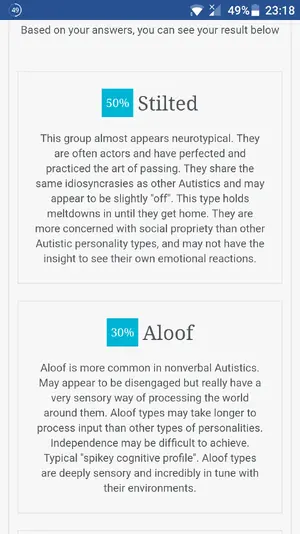Everyone educated enough in autism knows despite sharing a lot of similarities, we are all different.
Lorna Wing described autistic people as being in one or in a few categories. They are:
Aloof
Most frequent subtype among the lower functioning. Most high-functioning in this group are a mixture of aloof and passive. Limited language use. Copes with life using autistic routines. Most are recognised in childhood. Independence is difficult to achieve. There may be loneliness and sadness beneath the aloofness. Rain Man is an excellent example of this subgroup.
Passive
Often amiable, gentle, and easily led. Those passive rather than aloof from infancy may fit AS. More likely than the aloof to have had a mainstream education, and their psych skill profiles are less uneven. Social approaches passively accepted (little response or show of feelings). Characteristic autistic egocentricity less obvious in this group than in others. Activities are limited and repetitive, but less so than other autistics. Can react with unexpected anger or distress. Recognition of their autism depends more on observing the absence of the social and creative aspects of normal development than the presence of positive abnormalities. The general amenability is an advantage in work, and they are reliable, but sometimes their passivity and naivete can cause great problems. If undiagnosed, parents and teachers may be disappointed they cannot keep a job at the level predicted from their school work.
Active-but-odd
Can fall in any of the other groups in early childhood. Some show early developmental course of Kanner’s, some show AS. Some have the characteristic picture of higher visuospatial abilities, others have better verbal scores (mainly due to wide vocabulary and memory for facts). May be specific learning disorders (e.g., numerical). School placement often difficult. They show social naivete, odd, persistent approaches to others, and are uncooperative in uninteresting tasks. Diagnosis often missed. Tend to look at people too long and hard. Circumscribed interests in subjects are common.
Stilted
Few, if any clues to the underlying subtle handicap upon first meeting. The features of AS are particularly frequent. Early histories vary. Normal range of ability with some peaks of performance. Polite and conventional. Manage well at work. Sometimes pompous and long-winded style of speech. Problems arise in family relationships, where spontaneity and empathy are required. Poor judgement as to the relative importance of different demands on their time. Characteristically pursue interests to the exclusion of everything and everyone else. May have temper tantrums or aggression if routine broken at home, but are polite at work. Diagnosis very often missed. Most attend mainstream schools. Independence achieved in most cases. This group shades into the eccentric end of normality.
There is a 10 question quiz you can take to help determine if you're not sure. The link is at the bottom of this page. Be aware though that they do want your email address at the end. Give them an old email address or try a 10 minute mail address
Lorna Wing described autistic people as being in one or in a few categories. They are:
Aloof
Most frequent subtype among the lower functioning. Most high-functioning in this group are a mixture of aloof and passive. Limited language use. Copes with life using autistic routines. Most are recognised in childhood. Independence is difficult to achieve. There may be loneliness and sadness beneath the aloofness. Rain Man is an excellent example of this subgroup.
Passive
Often amiable, gentle, and easily led. Those passive rather than aloof from infancy may fit AS. More likely than the aloof to have had a mainstream education, and their psych skill profiles are less uneven. Social approaches passively accepted (little response or show of feelings). Characteristic autistic egocentricity less obvious in this group than in others. Activities are limited and repetitive, but less so than other autistics. Can react with unexpected anger or distress. Recognition of their autism depends more on observing the absence of the social and creative aspects of normal development than the presence of positive abnormalities. The general amenability is an advantage in work, and they are reliable, but sometimes their passivity and naivete can cause great problems. If undiagnosed, parents and teachers may be disappointed they cannot keep a job at the level predicted from their school work.
Active-but-odd
Can fall in any of the other groups in early childhood. Some show early developmental course of Kanner’s, some show AS. Some have the characteristic picture of higher visuospatial abilities, others have better verbal scores (mainly due to wide vocabulary and memory for facts). May be specific learning disorders (e.g., numerical). School placement often difficult. They show social naivete, odd, persistent approaches to others, and are uncooperative in uninteresting tasks. Diagnosis often missed. Tend to look at people too long and hard. Circumscribed interests in subjects are common.
Stilted
Few, if any clues to the underlying subtle handicap upon first meeting. The features of AS are particularly frequent. Early histories vary. Normal range of ability with some peaks of performance. Polite and conventional. Manage well at work. Sometimes pompous and long-winded style of speech. Problems arise in family relationships, where spontaneity and empathy are required. Poor judgement as to the relative importance of different demands on their time. Characteristically pursue interests to the exclusion of everything and everyone else. May have temper tantrums or aggression if routine broken at home, but are polite at work. Diagnosis very often missed. Most attend mainstream schools. Independence achieved in most cases. This group shades into the eccentric end of normality.
There is a 10 question quiz you can take to help determine if you're not sure. The link is at the bottom of this page. Be aware though that they do want your email address at the end. Give them an old email address or try a 10 minute mail address

